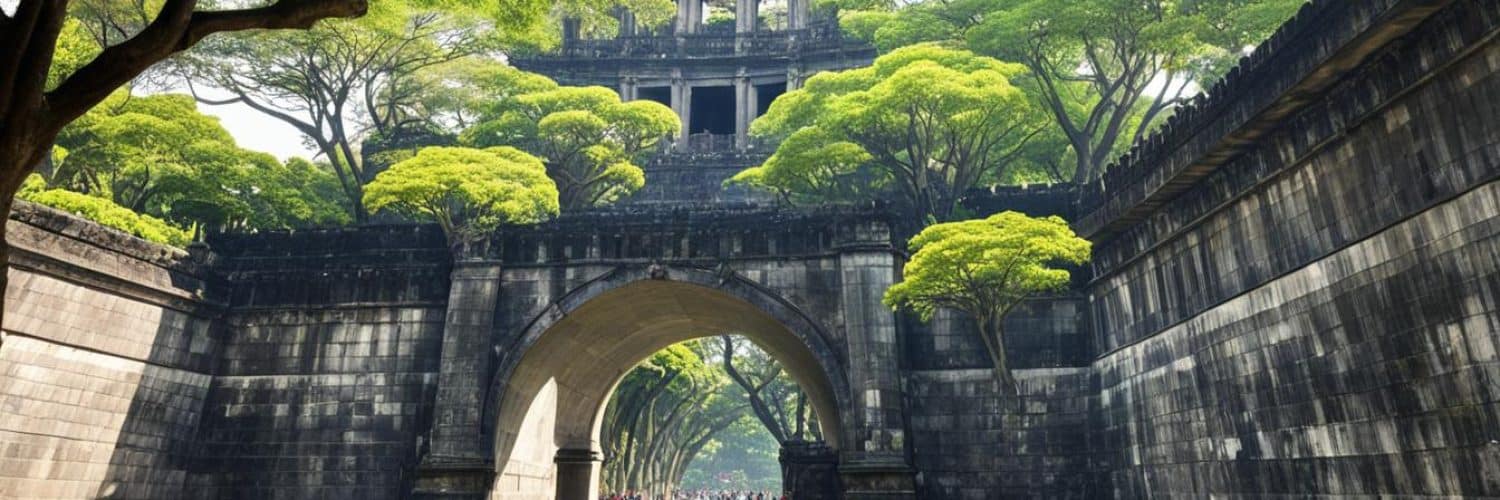Fort Santiago, located in the heart of Manila, is a historical fortress that takes visitors on a captivating journey through the Spanish colonial period. Built in 1571 by the Spaniards, this iconic landmark has witnessed centuries of history and served various purposes, including as a headquarters, prison, and depot for occupying forces. Today, Fort Santiago stands as a significant tourist attraction, allowing visitors to delve into the rich heritage of Manila and learn about the life and legacy of national hero, Dr. Jose Rizal.
Located within the walled city of Intramuros, Fort Santiago offers a myriad of captivating sights and experiences. From exploring the dungeons where prisoners were once held to paying homage at the Rizal Shrine, there is much to discover within these storied walls. As you walk through the fort, take in the breathtaking views of Manila Bay and visit the nearby Manila Cathedral, a magnificent symbol of the city’s strong Catholic heritage.
Key Takeaways:
- Fort Santiago is a historic fortress in Manila that provides a glimpse into the Spanish colonial period.
- It served as a headquarters, prison, and depot throughout its history.
- Visitors can explore the dungeons, visit the Rizal Shrine, and enjoy stunning views of Manila Bay.
- Located within Intramuros, the walled city, Fort Santiago offers a deep connection to Manila’s past.
- Make sure to visit the nearby Manila Cathedral and immerse yourself in the city’s vibrant Catholic heritage.
Ticket Booth and Operating Hours
When planning your visit to Fort Santiago, make sure to stop by the Ticket Booth to purchase your entry tickets. The Ticket Booth conveniently provides all the information you need to start your exploration of this historical fortress.
Before heading to Fort Santiago, it’s important to check the operating hours to ensure that you can make the most of your visit. The fortress opens its doors at a specific time and closes in the evening, allowing visitors ample time to explore and immerse themselves in its rich history.
Don’t forget to take note of the fees for entry into Fort Santiago. These fees vary depending on factors such as age, nationality, and any available discounts for students or seniors. Be sure to check the official website or contact the tourism information center for detailed information on ticket prices and other admission requirements.
As you plan your visit, there are a few reminders to keep in mind. Fort Santiago is a popular tourist attraction, so it’s advisable to arrive early to avoid long queues at the Ticket Booth. Additionally, wearing comfortable shoes and bringing sunscreen and water can enhance your experience as you explore the fort and its surroundings.
Intramuros Visitors Center
The Baluartillo de San Francisco Javier within Fort Santiago houses the Intramuros Visitors Center. This center serves as an information hub for visitors, providing details about the historical site, guided tours, and other relevant information. Explore the rich history of Fort Santiago and enhance your visit with the resources available at the Intramuros Visitors Center.
The center offers a range of facilities and services to enhance your experience:
- Information Center: Get comprehensive information about the fort, its architecture, and historical significance.
- Audio-Visual Chamber: Immerse yourself in the sights and sounds of the past through captivating audio-visual presentations.
- Refreshment Kiosks: Take a break and enjoy refreshments available at the kiosks, offering a variety of snacks and beverages.
- Souvenir Shops: Commemorate your visit with a wide selection of souvenirs that capture the essence of Fort Santiago and its significance.
Make the most of your visit to Fort Santiago by visiting the Intramuros Visitors Center. It is the perfect starting point to gather information, plan your tour, and create lasting memories. Discover the captivating history of Fort Santiago and take a piece of it home with you.
“The Intramuros Visitors Center provides a wealth of information and amenities to enhance the visitor experience, making it an essential stop for anyone exploring Fort Santiago.” – Traveler Review
Security Booth
Ensuring the safety and security of visitors is a top priority at Fort Santiago. Located within the premises, the Security Booth plays a crucial role in implementing necessary measures to maintain a safe environment for exploration and enjoyment of this historical site.
The dedicated security personnel at the booth are trained to handle various situations and provide assistance to visitors. They are equipped with the latest security technology and are vigilant in monitoring the premises.
Visitors can approach the Security Booth for any safety concerns or inquiries they may have. The knowledgeable staff is happy to provide information about safety measures and guidelines to ensure a smooth and secure experience at Fort Santiago.
“The safety and well-being of our visitors are of utmost importance to us. We have implemented strict security protocols and trained our personnel to ensure a safe environment for all,” says [Name], the Security Manager at Fort Santiago.
Safety Measures at Fort Santiago
Fort Santiago takes several safety measures to protect its visitors and preserve the historical site:
- Security personnel stationed at strategic locations throughout the fort
- Surveillance cameras to monitor the premises
- Regular inspections and maintenance of the fort’s infrastructure
- Emergency exits and evacuation plans in case of emergencies
- Clear signage and directions to navigate the fort safely
The Security Booth also collaborates closely with local law enforcement agencies to ensure a coordinated response in the event of any emergency or security incident.
By prioritizing the safety of its visitors, Fort Santiago aims to provide a memorable and worry-free experience for all who explore its fascinating history and architectural beauty.
| Safety Measures at Fort Santiago | Description |
|---|---|
| Security Personnel | Dedicated security personnel stationed strategically |
| Surveillance Cameras | High-quality cameras monitor the premises |
| Inspections and Maintenance | Regular checks to ensure infrastructure integrity |
| Emergency Exits | Clearly marked exits and evacuation plans |
| Signage and Directions | Clear instructions for safe navigation within the fort |
Almacenes Reales: Storage for the Royal Warehouses
Located across the plaza from Fort Santiago, the Almacenes Reales, also known as the Royal Warehouses, offer a fascinating glimpse into Manila’s trade and logistics during the Spanish colonial period. Built in the 16th century, these warehouses served as a crucial storage facility for goods unloaded at the nearby river gate. They housed supplies not only for the fort but also for various government offices.
The Almacenes Reales, once a bustling hub of activity, played a vital role in sustaining the Spanish colonial administration in Manila. Although partially leveled for access to river wharves, the remaining ruins bear witness to the significance of this site in facilitating the flow of goods and supporting the operations of the government.
“The Almacenes Reales stood as a testament to the vibrant trade and efficient logistics that characterized Manila during the 16th century, serving as a vital lifeline for the fort and the administrative machinery of the Spanish colonial government.” – Local Historian
This historical site provides visitors with a unique opportunity to imagine the bustling activity that once took place within its walls. The remnants of the Almacenes Reales stand as a silent reminder of Manila’s rich trading history, connecting us to the past and highlighting the enduring importance of commerce and governance in shaping the city.
Comparison of Almacenes Reales and Royal Warehouses
| Features | Almacenes Reales | Royal Warehouses |
|---|---|---|
| Construction Period | 16th century | Various periods, including 16th century |
| Function | Storage facility for goods and supplies | Storage facility for a wide range of goods |
| Location | Across the plaza from Fort Santiago | Adjacent to Fort Santiago |
| Significance | Storage for fort and government offices | Central storage for various purposes |
This table provides a quick comparison between the Almacenes Reales and the Royal Warehouses, showcasing their similarities and differences in terms of construction period, function, location, and significance.
Plaza Moriones
Plaza Moriones, named after Spanish Governor-General Domingo Moriones, offers a fascinating glimpse into the history of Fort Santiago. Once a vibrant public promenade, the plaza suffered destruction due to an earthquake in 1863. During that time, the surrounding area was utilized as soldier barracks, a testament to the fort’s military significance. In recent years, the Tourism Infrastructure and Enterprise Zone Authority (TIEZA) has undertaken the task of re-landscaping Plaza Moriones, breathing new life into this historic space.
Through careful planning and restoration efforts, TIEZA has revitalized Plaza Moriones as a magnificent public square within the fortified walls of Fort Santiago. Now, visitors have the opportunity to explore a reimagined plaza that combines the rich heritage of the past with modern amenities and a rejuvenated atmosphere.
Reimagining Plaza Moriones
The re-landscaped Plaza Moriones offers a diverse range of features and attractions for visitors to enjoy. From serene pathways to lush green spaces, there are various elements that enhance the overall visitor experience. Additionally, the plaza incorporates seating areas to provide a comfortable space for relaxation and contemplation.
One of the highlights of the reimagined Plaza Moriones is the incorporation of historical elements that pay homage to its past. Visitors can explore informative markers and plaques that provide insights into the significance of the plaza and its connection to Spanish Governor-General Domingo Moriones. These historical elements help create a deeper appreciation for the heritage of the surrounding area.
Elevating the Visitor Experience
Plaza Moriones is not only a historic site but also a vibrant hub for leisure and entertainment. It hosts various cultural events, performances, and exhibitions that showcase the rich traditions and talents of the local community. Visitors can immerse themselves in the lively atmosphere and engage with the local culture.
Moreover, the reimagined plaza includes amenities such as refreshment kiosks, offering a variety of delectable snacks and beverages that cater to diverse taste preferences. This addition allows visitors to indulge in culinary delights amidst the picturesque surroundings of the fort.
A Tribute to History and Progress
The re-landscaping of Plaza Moriones exemplifies the dedication to preserving and celebrating the historical significance of Fort Santiago. It serves as a testament to the commitment of TIEZA in ensuring the cultural continuity and promoting the economic sustainability of this iconic site. By reinvigorating Plaza Moriones, TIEZA not only enhances the visitor experience but also promotes environmental stewardship by maintaining the delicate balance between preservation and modern development.
| Features | Benefits |
|---|---|
| Restored historical elements | Deepens understanding of the plaza’s significance |
| Rejuvenated atmosphere | Provides a captivating environment for visitors |
| Cultural events and exhibitions | Engages visitors with the local community and traditions |
| Refreshment kiosks | Enhances the culinary experience for visitors |
“Plaza Moriones stands as a tribute to both history and progress, inviting visitors to immerse themselves in the rich heritage of Fort Santiago while enjoying the modern amenities and entertainment it has to offer.”– Anonymous
Baluartillo de San Francisco Javier
The Baluartillo de San Francisco Javier is a significant fortification that was constructed in 1662 as an integral part of the seafront defense system of Intramuros, Manila. This formidable structure, named after St. Francis Xavier, played a crucial role in safeguarding the city against maritime attacks during the Spanish colonial period. It is a testament to the strategic importance of seafront defense in protecting Intramuros and its inhabitants.
The Baluartillo de San Francisco Javier is characterized by its robust curtain wall, which provided a strong line of defense along the waterfront. The curtain wall’s imposing height and solid construction made it a formidable barrier against potential invaders, demonstrating the military expertise of the Spanish colonial forces.
Over the years, the Baluartillo de San Francisco Javier has undergone various transformations. Initially, it served mainly as storage chambers for military supplies and equipment until the early 20th century. These chambers were essential for sustaining the defensive capabilities of the fortification.
Today, the legacy of the Baluartillo de San Francisco Javier is preserved and celebrated through its role as the Intramuros Visitors Center. This state-of-the-art center provides tourists and history enthusiasts with a wealth of information about the historical significance of the fortification and the rich cultural heritage of Intramuros.
The Intramuros Visitors Center, housed within the Baluartillo de San Francisco Javier, offers a range of facilities to enhance the visitor experience. The information center provides detailed insights into the fortification’s history, architecture, and military significance. Visitors can explore these aspects through the center’s interactive displays and exhibits.
In addition to the information center, the Intramuros Visitors Center features an audio-visual chamber, where visitors can immerse themselves in multimedia presentations that bring the history of the Baluartillo de San Francisco Javier to life. The chamber offers a captivating audio-visual experience, providing a deeper understanding of the fortification’s role in defending Intramuros.
For those in need of refreshments, the center also includes convenient refreshment kiosks, allowing visitors to replenish their energy while continuing their exploration of Intramuros. Moreover, souvenir shops within the center offer an array of mementos and keepsakes, allowing visitors to take home a tangible reminder of their visit to this historic site.
The Baluartillo de San Francisco Javier, with its transformation into the Intramuros Visitors Center, stands as a powerful testament to the significance of historical preservation and cultural continuity. By providing a platform for education, appreciation, and enjoyment, this fortification ensures that the legacy of St. Francis Xavier and the seafront defense of Intramuros will endure for generations to come.
| Facilities | Description |
|---|---|
| Information Center | Offers detailed insights into the history and significance of the Baluartillo de San Francisco Javier, Intramuros, and related historical sites within the area. |
| Audio-Visual Chamber | Provides immersive multimedia presentations that bring the history and defense strategies of the fortification to life, enhancing the visitor’s understanding and appreciation. |
| Refreshment Kiosks | Conveniently located within the Intramuros Visitors Center, these kiosks offer a variety of snacks and beverages to replenish visitors’ energy during their exploration. |
| Souvenir Shops | Offer a diverse selection of mementos, gifts, and souvenirs for visitors to commemorate their visit to the Baluartillo de San Francisco Javier and Intramuros. |
Reducto de San Francisco Javier
The Reducto de San Francisco Javier is an integral part of Fort Santiago’s seaside defense system. Constructed in 1773, it served as a strategic fortification to protect the fort from potential attacks by sea. This defensive structure played a crucial role in ensuring the security of Fort Santiago and the surrounding area.
In addition to its defensive function, the Reducto de San Francisco Javier also served as an ammunition storage facility. It housed an extensive supply of ammunition and food provisions, ensuring that Fort Santiago was well-prepared to withstand any siege or prolonged conflict.
“The Reducto de San Francisco Javier was a crucial component of Fort Santiago’s coastal defense. Its strategic location and well-stocked ammunition storage were essential in safeguarding the fort from maritime threats.” – Local Historian
Today, the Reducto de San Francisco Javier stands as a testament to the rich history of Fort Santiago. After undergoing restoration efforts, it now serves a different purpose within the fort. This historic structure has been transformed into the serene Our Lady of Guadalupe chapel.
Our Lady of Guadalupe chapel provides visitors with a tranquil space for prayer, worship, and spiritual reflection within the historic walls of Fort Santiago. It offers a beautiful setting to appreciate the rich cultural and religious heritage of the Philippines.
Ammunition and Food Storage Capacity at Reducto de San Francisco Javier
| Storage Capacity | Description |
|---|---|
| Ammunition | The Reducto de San Francisco Javier could store up to 10,000 rounds of various munitions, including cannonballs, musket balls, and gunpowder. |
| Food Supplies | It was capable of storing provisions such as salted meat, grains, and dried fruits to sustain the soldiers and inhabitants of Fort Santiago during extended periods of siege. |
The Reducto de San Francisco Javier’s dual role as a seaside defense structure and ammunition storage facility exemplifies the fort’s historical significance and its strategic importance in safeguarding Manila’s coast during the Spanish colonial period.
Ruins of the American Barracks and Wall of Martyrs
The ruins of the American Barracks, where former Philippine President Elpidio Quirino was imprisoned during the Japanese Occupation, can be found alongside the solid curtain wall of the Baluartillo de San Francisco Javier. Nearby is the Wall of Martyrs, a brass plaque that lists the survivors and honors the Filipinos who were incarcerated and tortured within Fort Santiago during World War II. The plaque serves as a reminder of the atrocities committed and the resilience of the Filipino people during this challenging period.
Conclusion
Exploring Fort Santiago and the surrounding Intramuros offers a unique opportunity to engage with the history and culture of Manila. Responsible tourism and heritage preservation play a crucial role in ensuring the continuation of cultural traditions, economic sustainability, and environmental stewardship.
By supporting local businesses and making conscious choices as visitors, we can contribute to the preservation of Fort Santiago and its significance in Philippine history. This includes respecting the historical site, following guidelines and regulations, and being mindful of the impact we have on the environment.
As we conclude our journey through the past, let us carry with us the stories and lessons learned, passing them on to future generations to honor the sacrifices made and celebrate the vibrant heritage of Manila’s Fort Santiago.
FAQ
How old is Fort Santiago?
Fort Santiago was built by the Spaniards in 1571, making it one of the oldest fortifications in Manila.
What can I see at Fort Santiago?
At Fort Santiago, you can explore the historical fortress, visit the Rizal Shrine, see the dungeons, and learn about the Spanish colonial period and the life of Dr. Jose Rizal.
Where can I purchase tickets for Fort Santiago?
You can purchase tickets at the Ticket Booth located at Fort Santiago. Make sure to check the operating hours, fees, and other reminders before planning your visit.
What can I find at the Intramuros Visitors Center?
The Intramuros Visitors Center, located at the Baluartillo de San Francisco Javier, serves as an information hub for visitors. It provides details about the historical site, guided tours, and other relevant information. It also features an audio-visual chamber, refreshment kiosks, and souvenir shops.
Is there a Security Booth at Fort Santiago?
Yes, there is a Security Booth located within Fort Santiago to ensure the safety and security of visitors.
What are the Almacenes Reales?
The Almacenes Reales, also known as the Royal Warehouses, were built in the 16th century. They served as storage for goods unloaded at the river gate and supplies for the fort and other government offices.
What happened to Plaza Moriones?
Plaza Moriones was once a public promenade until it was destroyed by an earthquake in 1863. The area surrounding the plaza was used as soldier barracks. In recent years, it has been re-landscaped by TIEZA and revitalized as a public space within the historic environment of Fort Santiago.
What is the significance of the Baluartillo de San Francisco Javier?
The Baluartillo de San Francisco Javier is a fortification built in 1662 as part of the seafront defense of Intramuros. It now houses the Intramuros Visitors Center, offering visitors information about the fort and its history.
What is the Reducto de San Francisco Javier?
The Reducto de San Francisco Javier, built in 1773, served as both a defensive structure and a storage area for ammunition and food supplies. Today, it has been restored and houses the chapel for Our Lady of Guadalupe.
What can I find at the ruins of the American Barracks?
The ruins of the American Barracks can be found alongside the solid curtain wall of the Baluartillo de San Francisco Javier. Nearby is the Wall of Martyrs, a brass plaque that lists the survivors and honors the Filipinos who were incarcerated and tortured within Fort Santiago during World War II.


















Add comment